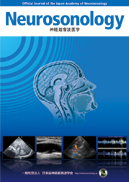巻号一覧

25 巻 (2012)
- 3 号 p. 137-
- 2 号 p. 79-
- 1 号 p. 5-
25 巻, 2 号
選択された号の論文の4件中1~4を表示しています
- |<
- <
- 1
- >
- >|
目で見る神経超音波診断
-
矢坂 正弘, 湧川 佳幸, 岡田 靖原稿種別: 目で見る神経超音波診断
2013 年 25 巻 2 号 p. 79-80
発行日: 2013/01/31
公開日: 2013/02/12
ジャーナル フリーPDF形式でダウンロード (4019K)
原著
-
岡村 穏, 竹川 英宏, 鈴木 圭輔, 豊田 茂, 大谷 直由, 井上 晃男, 高田 悦雄, 平田 幸一原稿種別: 原著
2013 年 25 巻 2 号 p. 81-85
発行日: 2013/01/31
公開日: 2013/02/12
ジャーナル フリーThe acceleration time (AcT) ratio may be used to diagnose stenosis of the internal carotid artery (ICA). However, no study has evaluated the factors influencing AcT, other than stenosis of the ICA or common carotid artery (CCA), or aortic valve stenosis (AS). To elucidate the factors contributing to the prolongation of AcT, we evaluated 47 patients without severe stenosis of the CCA and ICA. A linear-array probe was set in the CCA 2 cm proximal to the carotid bulb and a convex-array probe was set in the ICA 3 cm distal to the origin of the ICA to measure the Doppler waveform. The AcT ratio was calculated as the ipsilateral AcT of the ICA / AcT of the CCA. We also performed echocardiography to evaluate AS, aortic regurgitation (AR), and ejection fraction (EF). Multiple regression analysis identified AS as a significant determinant of AcT. However, no significant correlations were found between the AcT ratio and AR, EF value, age, sex, and laterality. In our study, AS was the only significant factor related to the prolongation of AcT; other aortic valve diseases did not influence the AcT ratio.抄録全体を表示PDF形式でダウンロード (774K)
症例報告
-
島田 佳明, 田中 康貴, 山田 大介, 宮元 伸和, 卜部 貴夫原稿種別: 症例報告
2013 年 25 巻 2 号 p. 86-90
発行日: 2013/01/31
公開日: 2013/02/12
ジャーナル フリーAcute type A aortic dissection still carries high morbidity and mortality. Sometimes aortic dissection triggers neurological symptoms mainly associated with stroke.
We report the case of a 57-year-old man with a history of aortic valve and thoracic aorta replacement for type A aortic dissection. He suddenly experienced motor aphasia. Magnetic resonance imaging revealed a left middle cerebral artery (MCA) territory infarction on diffusion-weighted images. Computed tomography confirmed a chronic type A dissection with persistent blood flow into the false lumen at the thoracic aorta and left common carotid artery. In transcranial Doppler monitoring, microembolic signals were observed only at the left MCA. Therefore, the thrombus came from only the left carotid artery, not the aortic valve or aortic arch. Anti-coagulant therapy reduced the number of microembolic signals at the left MCA. After starting that treatment, no new neurological deficits were found and no new lesions were detected on magnetic resonance images.
Transcranial Doppler ultrasonography monitoring is useful for evaluating the etiology of cerebral infarction and predicting clinical courses.抄録全体を表示PDF形式でダウンロード (2386K) -
安原 由子, 酒巻 咲子, 谷岡 哲也, 元木 一志, 笹川 知位子, 高瀬 憲作, 川西 千恵美原稿種別: 症例報告
2013 年 25 巻 2 号 p. 91-94
発行日: 2013/01/31
公開日: 2013/02/12
ジャーナル フリーThe administration of an intramuscular injection (IMI) is a basic nursing skill, primarily involving the gluteus and deltoid muscles. Nurses must determine the appropriate needle type, gauge, and depth of insertion for giving an IMI while avoiding injury to blood vessels and nerves. The primary purposes of this study were to determine the appropriate depth of injection for administering risperidone long-acting injectable (RLAI) and to evaluate the injected drug absorption using B-mode ultrasonography. In this study, the subjects were three patients with schizophrenia being treated with RLAI. The IMI procedures were monitored using B-mode ultrasonography during the injection of RLAI. One patient received an adequate injection in the gluteus medius muscle; however, the other two patients received inadequately positioned injections. Ultrasonography was useful for checking the absorption progress of the RLAI-loaded microspheres.抄録全体を表示PDF形式でダウンロード (3616K)
- |<
- <
- 1
- >
- >|